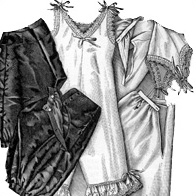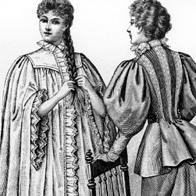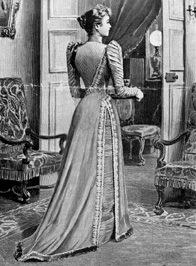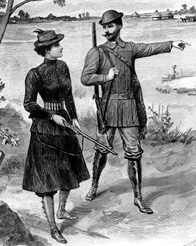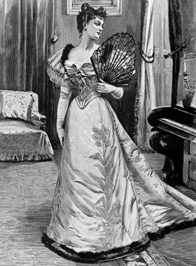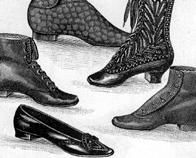Here you can find detailed information on the female clothing word during the late 19th century. For an overview of the clothing worn within the Alienist books, or for detailed information on male and child clothing during the late 19th century, please use the menu.
Female Clothing in the Alienist Books
Undergarments
Women’s underwear was extremely feminine in the 1890s with lace trimming, ribbons, and numerous frills. Base undergarments included a sleeveless chemise and drawers that reached just below the knee. Some women preferred to wear a joined chemise and drawers, known as a ‘combination’. Bloomers were also starting to gain popularity toward the end of the decade as an alternative to drawers.1 Base undergarments from 1896, including a pair of black bloomers, can be seen in the fashion plate to the left.
A corset was then worn over these articles and elastic suspenders were usually attached to the corset to hold up the stockings. The corset in the 1890s could be very beautiful. It was usually made of sateen or satin and came in a variety of colours, usually with embroidery. An hourglass shape was desired, although the S-bend became popular by the 1900s. In order to protect the outer dress or blouse, a corset cover or petticoat bodice was also worn. One or two petticoats were then put on over the top of these undergarments. Although the bustle, highly popular throughout the 1880s, was no longer fashionable, a small bustle pad was still sometimes worn to add fullness to the hips.1
Night Wear
Ankle-length nightgowns with long sleeves were usual. These opened from the front, with buttons from collar to waist. Some had shirred or tucked fronts. More elaborate dressing gowns with lace, ribbons, and frill trimmings were worn over these nightgowns prior to going to bed or when dressing in the morning. These were long enough to reach the knees or the ground, were loose and unfitted, and had three-quarter-length or long sleeves. In addition, combing sacques that only reached the waist and were held together by a ribbon or buttons near the collar were sometimes worn by upper class women when brushing the hair in order to protect their clothing underneath.2
Blouses
Also known as a ‘shirt-waist’, the blouse came in a variety of styles ranging from the highly masculine, with high-necked detachable starched collars and cuffs, to the extremely feminine, with extensive lace work and frills.2,3 The sleeves of the early 1890s were slim and had small gathers at the shoulder to provide minimal volume. Shoulder volume gradually increased from 1893, culminating in 1896 with ‘leg-of-mutton’ sleeves. This rather impractical fad died away by the end of the year, however, and slim fitting sleeves were popular again from 1897.2
Skirts
During the 1890s, skirts were much plainer than had previously been seen. They emphasised the waist, fit closely over the hips, and extended to the hem in something of an A-line. They were longer in the back than the front. Some were gored or pleated.1 A variety of solid colours and patterns (e.g., plaid) were worn during this period. Common skirt fabrics included fine wool, elastic wool, velvet, gingham, serge, silk, and cotton. They sometimes had ruffles and could be trimmed in velvet, fur, satin, and silk.2
Coats, Capes, Cloaks, and Jackets
Simple white blouses and skirts were often combined with a matching jacket to form a ‘suit’ for both formal and informal daytime wear. Suits were sometimes worn with a tie and vest, or waistcoat, as well.1 An example suit from 1890 can be seen to the left. Throughout the decade, jackets had sleeve volumes that matched those on the accompanying blouses. They were usually waist or 3/4 length, could be single or double breasted, and could have revers or standing collars. Jacket revers varied in width from narrow to very wide and could be faced with a variety of different fabrics. They were usually triangular in shape so that they pointed out toward the shoulders.2
Capes could also be worn over a jacket or in place of a jacket. These typically fell to the waist in pleats or full folds from the shoulders. High flaring collars were the norm. Capes and their collars could be made from cloth, velvet, or fur. Decorative embroidery on the collar and extensive fur or feather trimming were also common. Coats, worn in winter over dresses and suits, were made of furs or heavy fabrics. They were typically æ or full length and their revers were much like those of jackets, except that a wide width was usually preferred. Finally, dust cloaks were worn when travelling to protect the dress beneath. They were made of fabrics with glossy surfaces in order to repel dust and were large enough to cover an entire dress.2
Dresses
Dresses had bodices and skirts that were similar in style to separate blouses and skirts. However, unlike separate blouses and skirts that could be worn in different combinations, dresses were designed to be worn as a whole and had trimming that unified bodice and skirt. High necklines were popular throughout the decade and the waist was usually emphasised with a wide fabric belt. ‘Seamless’ dresses were also experimented with. These were made of elastic wool which made them easier to tailor given that the seams needed to be kept to a bare minimum.2 An example of an 1892 seamless dress is illustrated in the fashion plate to the right.
Sports Wear
The growth of sporting activities available to women in the 1890s, particularly in America, had a very strong influence on fashion. Women participated in riding, hunting, shooting, tennis, archery, fencing, golf, hockey, cricket, ice-skating, roller-skating, cycling, and swimming. This resulted in the development of a wide variety of sporting costumes that were both fashionable and liberating.1 As there are simply too many different costumes to describe, only a lady’s shooting costume, such as the one Sara Howard might have preferred wearing, is mentioned here. As can be seen in the 1893 fashion plate to the left, this costume consisted of a high-necked jacket, a knee-length skirt, and a matching pair of bloomers underneath the skirt. In the fashion plate, a wide leather belt with slots to hold ammunition was then worn over the jacket. Additionally, a small Homburg-type hat and knee high leather boots with a very low heel accompanied the outfit.2
Formal Evening Wear
Evening gowns worn for formal events such as dinners, balls, and operas were extremely elegant and as with daywear, the hourglass silhouette was desired. This was achieved with tight-fitting bodices and A-line skirts that were longer in the back than the front. Short trains were sometimes added to the skirt to exaggerate the desired shape. On the bodice, cap sleeves were preferred in the early 1890s; by the middle of the decade, short leg-of-mutton sleeves were fashionable; and from 1897 onwards, cap sleeves had again returned to popularity. Throughout the decade, pointed waists were standard and necklines were low. Common evening gown fabrics included satin, velvet, silk, tulle, chiffon, brocade, moire, or damask. They were trimmed with lace, pearls, fur, crystal, embroidery, or feathers. An evening dress from 1894 is shown to the right. It was made of light-blue satin, embroidered with beads, and bordered with black fur. Note the short leg-of-mutton sleeves. Evening cloaks that covered the entire gown were worn when travelling to formal events. These had a cape and openings on each side that formed large, long sleeves.2
Hairstyles
Hair was pulled back from the forehead to a twist or bun on the top of the head. Sometimes pads were placed under the hair to give it a full soft ‘bouffant’ style.1
Hats
Fashionable hats during the 1890s were wide-brimmed and worn high. Most were decorated with ribbons, flowers, feathers, birds, and trimmings, or were draped in velvet, silk, or tulle. Bonnets, although fashionable throughout the 19th century and into the 1880s, were not popular during this decade.1
Shoes
Women’s shoes during this period varied considerably. Boots, slippers, and court shoes could be made of satin, leather, or cloth. Some had high heels and were extremely ornamental with ribbons and bows for decoration.1 More practical walking boots and shoes were also available. These had low heels, were buckled or laced, and ranged from ankle, to calf, to knee high.2 Examples of walking shoes and boots from 1892 can be seen in the fashion plate to the right.
Stockings
Day stockings were made of fine lisle, cotton, or wool. Evening stockings were made of silk and had embroidery or lace decorating the instep. From the 1880s, stockings could range in colour from light shades to black.1
Gloves
During the day, women’s gloves were short or three-quarter-length. In the evening, long gloves of elbow length were worn. All were close fitting and came in a variety of colours, from light shades to black.1
Aprons
In previous years, small pretty aprons were worn by fashionable women for sewing but by the 1890s, they were mainly for practical use. Housewives, cooks, parlour maids, teachers, governesses, and shop assistants all wore aprons over their clothes while working. These were made of gingham, linen, or sateen.1
Accessories
In summer, parasols were often carried. These had long handles and were considerably larger than had previously been fashionable. They were often ruffled, trimmed with silk or lace, and were usually light coloured. If a lady was wearing a suit or if the weather was poor, a silk-covered umbrella might be carried instead.1 Elaborately decorated fans were also carried during the day and in the evening. These could be made of a variety of materials including wood, silk, lace, and tulle. In winter, fashionable women carried large muffs instead of parasols. These were made of a variety of fabrics and furs including sealskin, Persian lamb, sable, and chinchilla.2
Jewellery was smaller during the 1890s than in previous decades and included brooches, bracelets, earrings, rings, lockets, and cameos.1 Watches were attached to ornamental brooches or watch pins. If a woman needed to carry anything else, she carried a purse or fastened a chatelaine bag to a decorative belt buckle; leather belts with ornamental metal mountings were frequently worn with skirts during this period.1,2
References
1. Nunn, Joan. Fashion in Costume 1200~2000. 2nd ed. Chicago: New Amsterdam Books, 2000.
2. Blum, Stella, ed. Victorian Fashions & Costumes from Harper’s Bazar 1867-1898. New York: Dover Publications, Inc., 1974.
3. Amneus, Cynthia. A Separate Sphere: Dressmakers in Cincinnati’s Golden Age 1877-1922. Texas: Texas Tech University Press, 2003.

